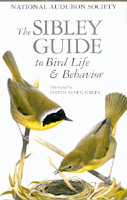Granny's Country Store > Nature & Wildlife > Bird Identification Guides | Search | View Cart

Bird Identification Books
-The Sibley Guides-
National Audubon Society
By David Allen Sibley
The process of learning to interpret bird language requires some bird identification skills. The easiest time to begin identifying birds is when there are the least of them around to confuse you. That would be winter here in the northern latitudes. But don't let that stop you from learning birds any time of year. Just start with the most common, most distinctive birds first and work your way gradually towards the LBB's or "little brown birds" that all look alike.
You can learn to identify birds by flipping through field guides in search of whatever birds you happen to see, but perhaps a better place to get started is with a "field guide to birding," such as Sibley's Birding Basics: How to identify birds, using the clues in feathers, habitats, behaviors, and sounds. With this book you can learn the skills that professional birders use to identify birds.
As for identication guides, there are many great bird books, but the most comprehensive is undoubtedly the 544 page National Audubon Society's Sibley Guide to Birds by David Allen Sibley. Sibley begin studying birds seriously at age 7, under the tutelage of his father. Unlike other guides, the Sibley Guide to Birds includes complete descriptions for all 816 bird species found in North America north of Mexico. Most species are pictured at rest and in flight, and from several angles, above and below. The pictures also show plummage in every stage of development and in both sexes, so you can see the complete range of variations within a species. Also included are descriptions of each bird's distinctive markings, plus range maps and migration routes. The book even includes measurements for the typical wingspan, length, and weight of the birds.
The Sibley Guide to Birds is encyclopedic in depth as well as in size. For field use we recommend the more portable Field Guide to Birds of Eastern North America and the Field Guide to Birds of Western North America.
Sibley planned the books for nearly twenty years and produced the fantastic life-like drawings--several thousand of them-- in just five years. One feature I especially like is that, if you are looking for one type of bird, like a warbler, then you can look at scaled down images on a single page covering all possible choices. That makes it easy to compare one species to another without constantly flipping back and forth through the pages. This is the sort of book that is so beautiful and so well organized that it is fun just to sit down and browse through the pages. The only thing lacking in the Sibley Guide to Birds is information about bird habits, such as nesting preferences, the number and type of eggs, and dietary choices, etc.... all of which is included in the equally impressive companion book The Sibley Guide to Bird Life & Behavior.
 The Sibley Guide to Bird Life & Behavior is a 588 page book dedicated to exhaustive coverage of the bird families of North America, including family traits, taxonomy, adaptations, feeding, breeding, vocalizations and displays, nesting, migration, and conservation. Nowhere else can you find so much information under one cover. The book is illustrated with more of David Allen Sibley's incredible artwork. Sibley provided more than 796 full-color paintings to illustrate the essays and family chapters written by 44 ornithologists and expert birders. Together, the pictures, text, and Sibley's lucid design and all-encompassing attention to detail make The Sibley Guide to Bird Life and Behavior as spectacular and as useful as its brilliant predecessor.
The Sibley Guide to Bird Life & Behavior is a 588 page book dedicated to exhaustive coverage of the bird families of North America, including family traits, taxonomy, adaptations, feeding, breeding, vocalizations and displays, nesting, migration, and conservation. Nowhere else can you find so much information under one cover. The book is illustrated with more of David Allen Sibley's incredible artwork. Sibley provided more than 796 full-color paintings to illustrate the essays and family chapters written by 44 ornithologists and expert birders. Together, the pictures, text, and Sibley's lucid design and all-encompassing attention to detail make The Sibley Guide to Bird Life and Behavior as spectacular and as useful as its brilliant predecessor.
Introductory essays outline the principles of avian evolution, life cycle, body structure, flight dynamics, and more. The 80 family-by-family chapters describe the amazing range of behavior dictated by birds' biology and environment. Among the subjects covered and illustrated are: molts and plumages, habitats, food and foraging, vocalizations and displays, courtship and breeding, rearing of young, migration and movements, scientific groupings, introduced species, accidental species, anatomy, flight patterns, nests and eggs, global distribution and conservation.
For birders and non-birders alike, in the classroom and at home, The Sibley Guide to Bird Life and Behavior will be the essential source for information on avian life.
-Please scroll down the page for the "Add to Order" button.-